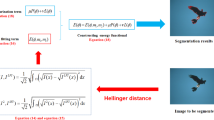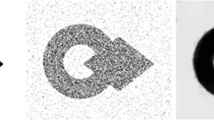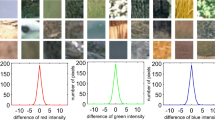Abstract
Due to the limitations in imaging devices and subject-induced susceptibility effect, general image segmentation is still an open problem. Typical challenges include image noise, intensity inhomogeneity and various image modalities. In this paper, we propose to use a two-step strategy. Specifically, we first utilize a mean curvature regularized Mumford-Shah model to recover an intermediate image with enhanced saliency, and then the segmentation is obtained by a thresholding procedure. For images with intensity inhomogeneity, a bias-corrected fuzzy K-means method is used to correct the bias field before K-means thresholding. The proposed model can be minimized efficiently using the augmented Lagrangian algorithm. Experimental results and comparison analysis demonstrate that the proposed framework is not only able to preserve the geometry of object shapes, especially object corners, but it is also more accurate than state-of-the-art methods.







Similar content being viewed by others
References
Ahmed MN, Yamany SM, Mohamed N, Farag AA, Moriarty T (2002) A modified fuzzy c-means algorithm for bias field estimation and segmentation of MRI data. IEEE Trans Med Imaging 21(3):193–199
Bao Z, Murray JI, Boyle T, Ooi SL, Sandel MJ, Waterston RH (2006) Automated cell lineage tracing in Caenorhabditis elegans. Proc Natl Acad Sci USA 103:2707–2712
Cai X, Chan R, Zeng T (2013) A two-stage image segmentation method using a convex variant of the Mumford-Shah model and thresholding. SIAM J Imaging Sci 6(1):368–390
Chan T, Vese LA (2001) Active contours without edges. IEEE Trans Image Process 10(2):266–277
Chan R, Yang HF, Zeng TY (2014) A two-stage image segmentation method for blurry images with Poisson or multiplicative gamma noise. SIAM J Imaging Sci 7(1):98–127
Cai X (2015) Variational image segmentation model coupled with image restoration achievements. Pattern Recogn 48(6):2029–2042
Duan Y, Chang H, Huang W, Zhou J, Zeng T (2014) A two-stage image segmentation method using Euler’s elastica regularized Mumford-Shah model. In: 22nd international conference on pattern recognition
Evans LC (1998) Partial differential equations. American Mathematical Society, Providence
Han X, Fischl B (2007) Atlas renormalization for improved brain MR image segmentation across scanner platforms. IEEE Trans Med Imaging 26(4):479–486
Hong C, Yu J, Tao D, Wang M (2015) Image-based three-dimensional human pose recovery by multiview locality-sensitive sparse retrieval. IEEE Trans Ind Electron 62(6):3742–3751
Hong C, Yu J, Wan J, Tao D, Wang M (2015) Multimodal deep autoencoder for human pose recovery. IEEE Trans Image Process 24(12):5659–5670
Hong C, Yu J, You J, Chen X, Tao D (2015) Multi-view ensemble manifold regularization for 3D object recognition. Inf Sci 320:395–405
http://www.eecs.berkeley.edu/Research/Projects/CS/vision/bsds/. The Berkeley segmentation dataset and benchmark
Li C, Huang R, Ding Z, Gatenby JC, Metaxas DN, Gore JC (2011) A level set method for image segmentation in the presence of intensity inhomogeneities with application to MRI. IEEE Trans Image Process 20(7):2007–2016
Li C, Kao CY, Gore JC, Ding Z (2008) Minimization of region-scalable fitting energy for image segmentation. IEEE Trans Image Process Publ IEEE Signal Process Soc 17(10):1940–1949
Li C, Kao C, Gore J, Ding Z (2007) Implicit active contours driven by local binary fitting energy. In: Proceedings of IEEE conference on computer vision and pattern recognition (CVPR), pp 1–7
Mumford D, Shah J (1985) Boundary detection by minimizing functionals. In: Proceedings of the IEEE conference on computer vision and pattern recognition, pp 22–26
Mumford D, Shah J (1989) Optimal approximations by piecewise smooth functions and associated variational problems. Commun Pure Appl Math 42:577–685
Piovano J, Rousson M, Papadopoulo T (2007) Efficient segmentation of piecewise smooth images. In: Scale space and variational methods in computer vision (SSVM07), Italy, Ischia, pp 709–720
Tan M, Hu Z, Wang B, Zhao J, Wang Y (2016) Robust object recognition via weakly supervised metric and template learning. Neurocomputing 181:96–107
Tsai A, Yezzi A, Willsky AS (2001) Curve evolution implementation of the Mumford-Shah functional for image segmentation, denoising, interpolation, and magnification. IEEE Trans Image Process 10:1169–1186
Vese LA, Chan TF (2002) A multiphase level set framework for image segmentation using the Mumford-Shah model. Int J Comput Vis 50:271–293
Yuan J, Bae E, Tai XC (2010) A study on continuous max-flow and min-cut approaches, In: Proceedings of the twenty-third ieee conference on computer vision and pattern recognition (CVPR), San Francisco, CA, pp 2217–2224
Yu J, Rui Y, Tao D (2014) Click prediction for web image reranking using multimodal sparse coding. IEEE Trans Imaging Process 23:2019–2032
Zhu W, Chan T (2012) Image denoising using mean curvature of image surface. SIAM J Imaging Sci 5(1):1–32
Zhang K, Song H, Zhang L (2010) Active contours driven by local image fitting energy. Pattern Recogn 43(4):1199–1206
Zhu W, Tai XC, Chan T (2014) A fast algorithm for a mean curvature based image denoising model using augmented lagrangian method. In: Efficient algorithms for global optimization methods in computer vision. Springer, Berlin Heidelberg, pp 104–118
Zhu W, Tai XC, Chan T (2013) Augmented Lagrangian method for a mean curvature based image denoising model. Inverse Probl Imaging 7(4):1409–1432
Acknowledgements
The author (D. X. Kong) was supported in part by the National Natural Science Foundation of China (Grant No. 91630311) and the Fundamental Research Funds for the Central Universities (Grant No. 2017XZZX007-02). The author (J. L. Peng) was supported in part by the National Natural Science Foundation of China (Nos. 11401231, 11771160), Natural Science Foundation of Fujian Province (No. 2015J01254) and the Promotion Program for Young and Middle-aged Teacher in Science and Technology Research of Huaqiao University (No. ZQN-PY411).
Author information
Authors and Affiliations
Corresponding author
Appendix: The Derivations in Tables 1 and 2.
Appendix: The Derivations in Tables 1 and 2.
In this “Appendix”, we discuss the corresponding functionals for each variable function u, q, p, n, m by fixing the other variable functions and show how to get the associated minimizers or the Euler–Lagrange equations. Similarly as in [28], these functionals can be written as follows.
The minimizers of the functionals \(\varepsilon _2(q)\), \(\varepsilon _3(p)\), \(\varepsilon _5(m)\) can be expressed explicitly, while the minimizers of functionals \(\varepsilon _1(u)\), \(\varepsilon _4(n)\) are determined by the associated Euler–Lagrange equations. For the sake of completeness of presentation, we present the details of how to minimize the subproblems here.
For the functional \(\varepsilon _1(u)\), since
where \((d_{1},d_{2},d_{3})=d=p + \frac{\lambda _2}{r_2}\), then one gets
where I is the identity operator, \(\partial _{x}^{T}\) is the tranapose of \(\partial _{x}\) and \(\partial _{y}^{T}\) is the tranapose of \(\partial _{y}\)
As the functional \(\varepsilon _2(q)\) can be reformulated as
where \(\tilde{q} = \partial _{x}n_1+\partial _{y}n_2-\frac{\lambda _3}{r_3}\), then by Lemma 1 in [28], one gets
Similarly, as
where \(\tilde{p} = <\nabla u,1> - \frac{\lambda _2}{r_2} + \frac{m(r_1+\lambda _1)}{r_2}\), \(\tilde{m} = n+\frac{\lambda _4}{r_4}+\frac{(r_1+\lambda _1)p}{r_4}\). By using Lemma 1 in [28], one obtains
By using Lemma 2 in [28], we get
As for the functional \(\varepsilon _4(n)\), standard procedures lead to the following Euler–Lagrange equations:
where \(n=(n_1,n_2,n_3)\), \(m=(m_1,m_2,m_3)\), \(\lambda _2=(\lambda _{21},\lambda _{22},\lambda _{23})\), \(\lambda _4=(\lambda _{41},\lambda _{42},\lambda _{43})\), \(h=(h_1,h_2,h_3)=m-\frac{\lambda _4}{r_4}\). Both u and n can be solved by the fast Fourier transform [28]. Moreover, based on the above formulations, we may update all the Lagrange multipliers:
where \(|p|=\sqrt{(p_{1})^2+(p_{2})^2+(p_{3})^2}\).
Rights and permissions
About this article
Cite this article
Ma, Q., Peng, J. & Kong, D. Image Segmentation via Mean Curvature Regularized Mumford-Shah Model and Thresholding. Neural Process Lett 48, 1227–1241 (2018). https://doi.org/10.1007/s11063-017-9763-7
Published:
Issue Date:
DOI: https://doi.org/10.1007/s11063-017-9763-7




